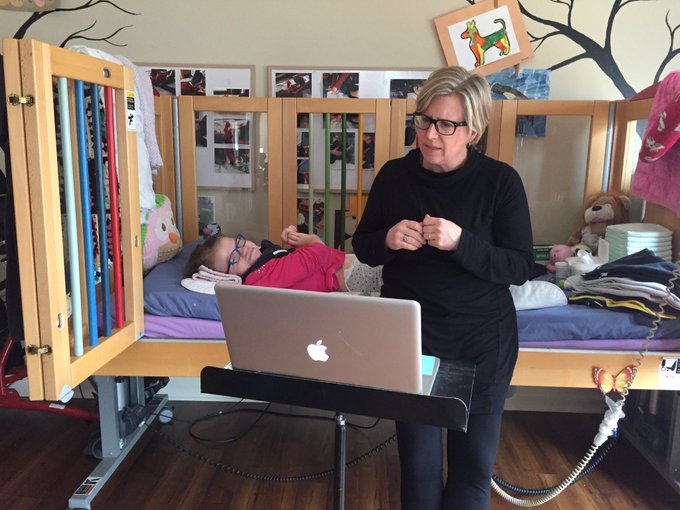
Online appointments deliver care and peace of mind
As a mother of four, including two daughters with significant medical needs, Sara Pot has her hands full on the best of days. But last week, she still took the time to share a photo on social media showing a virtual appointment with her daughter’s health care team.
“I wanted to assure families that might have been cautious about an online visit,” says Pot. “So people can see that it isn’t so difficult. In fact, it’s quite personal, in a strange sort of way.”
Virtual care during COVID-19
Some hospital services have had to pause entirely during COVID-19 so spread can be slowed and resources can be redeployed. But many essential Hamilton Health Sciences appointments have gone virtual. Virtual care can include phone calls, emails or a face-to-face online visit through a service such as the Ontario Telemedicine Network, or OTN.
Among the first to use virtual care are Pot, her daughter Rachel, and Rachel’s health care team, including clinical specialist Cindy van Halderen, in the Quality of Life and Advanced Care Program (QoLA Care) at McMaster Children’s Hospital. The QoLA Care program serves families affected by serious pediatric health conditions which impact quality of life. Services provided include promotion and facilitation of factors which add to quality of life and specific treatment of advanced pain and symptoms, among others.
“Before COVID we saw the Pot family in our outpatient clinic,” says van Halderen. “It was only when Sara contacted us with concerns at the same time COVID-19 was becoming an issue that we decided the best way to meet was virtually. It made sense to see Rachel using video conferencing technology first. Based on the virtual appointment, we could decide if her scoliosis pain needed further in-person investigation.”
Connecting from home
During the appointment, Pot sat on her daughter Rachel’s bed, with a laptop computer balanced on a music stand nearby.
“Knowing the COVID-19 virus is a very real concern, we were thankful to access her QoLa Care team without having to leave home,” says Pot. “Using the video option through OTN allowed the doctors to see Rachel while also listening to our concerns. Even though there was some initial awkwardness in handling the tech, it didn’t take long to figure out what would work.”
Pot points out that meeting online saved their family a significant amount of time and anxiety because she could skip the car ride, Rachel was relaxed in her own home and the appointments are scheduled for a specific start time.
“We have appreciated the opportunity to connect via phone, email, and video. This has saved us time and, more importantly, offered us peace of mind,” she says.
Access to the same records
Both Pot and van Halderen emphasize that there are times when an in-person appointment is necessary, such as when a physical examination is needed, but otherwise there’s not much difference between a virtual and in-person visit. Health care providers can access all the systems they need, and several people can join in the online appointment as appropriate.
“At the same time we can see the family on our monitor, we can also pull up the patient’s electronic medical record and various relevant scans,” says van Halderen. “On our screens we had Rachel’s recent x-rays and copies of recent notes from other sub-specialists. So like we do in clinic, we can pull up the full chart while talking the family.”
Efficient appointments
One difference van Halderen has noticed is a positive one.
“Surprisingly, the biggest difference is often the length of the visit,” she says. “Video visits, for whatever reason, tend to be shorter by half than a clinic visit. They’re efficient visits.”
During Rachel’s virtual visit, the family and team decided together on a plan of care, then the health care team emailed documentation of that plan to the family, and sent the prescription by fax to their pharmacy. The next steps will be to check in by email and then follow up with another OTN online meeting in two weeks.
Pot hopes more patients and care providers will be able to take advantage of virtual visits during COVID-19.
“Creating time and the capability to visit the hospital for assessments and regular check-ins for families of children with complex needs is, well, a complex job,” she says. “With our online visit, the sound and video quality were great, allowing us to talk without delays, and we were able to create a new pain plan for Rachel. Meeting specialists in your own space is a great way to create authentic family-centred care.”
Read more:
